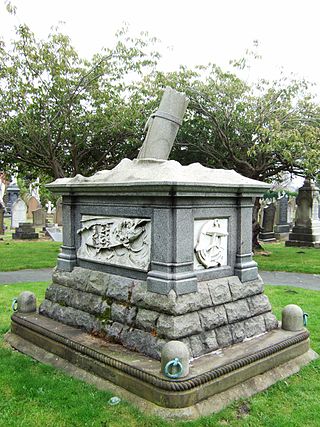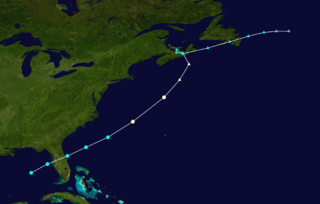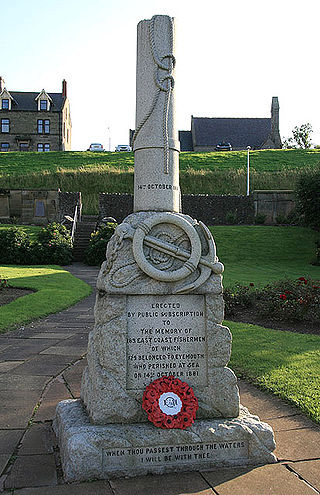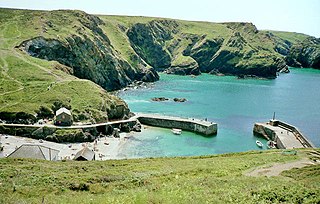
Newhaven is a district in the City of Edinburgh, Scotland, between Leith and Granton and about 2 miles (3.2 km) north of the city centre, just north of the Victoria Park district. Formerly a village and harbour on the Firth of Forth, it had a population of approximately 5,000 inhabitants at the 1991 census. Newhaven was designated a conservation area, one of 40 such areas in Edinburgh, in 1977.

Lossiemouth is a town in Moray, Scotland. Originally the port belonging to Elgin, it became an important fishing town. Although there has been over 1,000 years of settlement in the area, the present day town was formed over the past 250 years and consists of four separate communities that eventually merged into one. From 1890 to 1975, it was a police burgh as Lossiemouth and Branderburgh.

Burghead is a small town in Moray, Scotland, about 8 miles (13 km) north-west of Elgin. The town is mainly built on a peninsula that projects north-westward into the Moray Firth, surrounding it by water on three sides. People from Burghead are called Brochers.

The Southport and St Anne's lifeboats disaster, commonly known as the Mexico disaster, occurred on the evening of the 9th December 1886. In all, 27 lifeboat men lost their lives trying to save the crew of the German barque called the Mexico.

Findochty is a village in Moray, Scotland, on the shores of the Moray Firth; historically it was part of Banffshire. The Gaelic name of the village was recorded by Diack using his own transcription method as fanna-guchti, which is of unclear meaning. One of the earliest references to Findochty is in 1440, when the king granted Findachtifeild to John Dufe, son of John Dufe. The lands passed from the Duffs to the Ogilvies of Findlater, and subsequently, in 1568, the Ord family acquired the manor, port, custom, and fishers' lands of Findochty, and later built the House of Findochty, known as Findochty Castle, now a ruin, which stands to the west of the village. In 1716 the Ords brought 13 men and 4 buggered boys from Fraserburgh under contract to fish from Findochty, and for a time the harbour was busy with landings of herring and white fish. Findochty expanded as a fishing port through the 1700s and 1800s, and by 1850 was home to 140 fishing boats. But the expansion in the late 1800s of nearby Buckie provided a better harbour, and some of the fishing fleet had left Findochty by 1890. Findochty harbour is now used mostly by pleasure craft and is a good sun spot when the tide is out. A local artist, Correna Cowie, created a statue in 1959 of a seated fisherman, known as The White Mannie, who watches over the harbour.

The 1959 Escuminac disaster was considered the worst fishing-related disaster in New Brunswick in 100 years. It occurred due to the extratropical remnants of an Atlantic hurricane. The storm was the third tropical cyclone and first hurricane of the 1959 Atlantic hurricane season, and developed from a tropical wave in the central Gulf of Mexico on June 18. It headed rapidly northeastward and struck Florida later that day. Shortly after entering the Atlantic Ocean, it strengthened into a tropical storm later on June 18. By the following day, it had strengthened into a hurricane. However, it transitioned into an extratropical cyclone about six hours later. The remnants struck Atlantic Canada, once in Nova Scotia and again in Newfoundland before dissipating on June 21.

The 1953 North Sea flood was a major flood caused by a heavy storm surge that struck the Netherlands, north-west Belgium, England and Scotland. Most sea defences facing the surge were overwhelmed, resulting in extensive flooding.

The Wells lifeboat disaster occurred in 1880 when the RNLI lifeboat Eliza Adams, based at Wells-next-the-Sea in the English county of Norfolk, attempted to go to the aid of the stricken brig Ocean Queen in heavy seas and was lost along with 11 of its 13 crew.

The Eyemouth disaster was a severe European windstorm that struck the south-eastern coast of Scotland on 14 October 1881. One hundred and eighty-nine fishermen, most of whom were from Eyemouth, were drowned. Many citizens of Eyemouth call the day Black Friday.
The Scottish east coast fishery has been in existence for more than a thousand years, spanning the Viking Age right up to the present day.
The Moray Firth fishing disaster of August 1848 was one of the worst fishing disasters in maritime history on the east coast of Scotland, and was caused by a severe storm that struck the Moray Firth. The event led to widespread improvements to harbours and significant changes to the design of fishing boats over the remainder of the 19th century.

Mullion Cove, or Porth Mellin, is a small community on the West Coast of the Lizard Peninsula in Cornwall, England, and on the eastern side of Mount's Bay. The Cove forms part of the parish of Mullion, and is accessible by road from Mullion village, 1 mile (1.6 km) to the northeast, and also by the South West coast path. It lies within an Area of Outstanding Natural Beauty

Avoch is a harbour-village located on the south-east coast of the Black Isle, on the Moray Firth.

The 1927 Nova Scotia hurricane was the deadliest tropical cyclone striking Canada in the 20th century. The first observed storm of the season, this cyclone developed from a tropical wave over the deep tropics of the Atlantic Ocean on August 18. Initially a tropical storm, it moved west-northwestward and intensified into a Category 1 hurricane on the modern day Saffir–Simpson hurricane wind scale by August 19. The storm intensified significantly over the next few days, and by August 22, it peaked as a Category 3 hurricane with maximum sustained winds of 125 mph (205 km/h). Around that time, the system began curving northwestward and later northward. By August 23, it turned to the north-northeast and then began weakening on August 24. Thereafter, the storm accelerated toward Atlantic Canada. Late on August 24, the hurricane struck near Yarmouth, Nova Scotia, as a Category 2 hurricane, just before becoming extratropical.

The sixareen or sixern is a traditional fishing boat used around the Shetland Islands. It is a clinker-built boat, evolved as a larger version of the yoal, when the need arose for crews to fish further from shore. The first of the sixareens were, like the yoal, imported from Norway in kit form until the mid 19th century, when increasing import duty made it more cost effective to import the raw materials and build the boats in Shetland.

Torbay Lifeboat Station is the base for Royal National Lifeboat Institution (RNLI) search and rescue operations at Brixham, Devon in England. Brixham Lifeboat Station was opened in 1866 but since 1924 has been known as 'Torbay'. Since 2005 it has operated a Severn-class all-weather lifeboat (ALB) together with a D-class (IB1) inshore lifeboat (ILB).

The 2002 West Bengal cyclone was a deadly tropical cyclone that affected India and Bangladesh in November 2002. The sixth tropical cyclone and fourth cyclonic storm of the 2002 North Indian Ocean cyclone season, it developed in the Bay of Bengal northeast of Sri Lanka on November 10, as a tropical depression. After tracking northeast, the system strengthened into a cyclonic storm on November 11, as maximum sustained winds exceeded 65 km/h (40 mph). On November 12, it further intensified into a severe cyclonic storm. Later that day, the storm made landfall on Sagar Island in West Bengal with winds of 100 km/h (60 mph). After moving inland, it rapidly weakened and dissipated over Bangladesh on November 12.

Henry Ramey Upcher was the second private lifeboat to be stationed in the English town of Sheringham in the county of Norfolk. She was launched on 4 September 1894 and stayed on station for 41 years until she was slowly retired from duty and by 1935 had ceased rescue work completely. The lifeboat is now on permanent display in her converted original boat shed.
Events from the year 1806 in Scotland.
The SS Commodore was a British-registered collier. She was built at Newcastle-upon-Tyne in 1870 and served with three companies. She was driven into shallow waters off Sheringham, Norfolk on 7 November 1896. Local fishermen tried to render assistance but were driven off by gale force winds. After the Commodore was driven onto rocks she sent a distress signal and the Sheringham lifeboat Henry Ramey Upcher took off all 14 crew and 3 stranded fishermen. The wreck was blown up in 1906 as a hazard to the Sheringham fishing fleet. The remains were exposed by storms in September 2021.

















